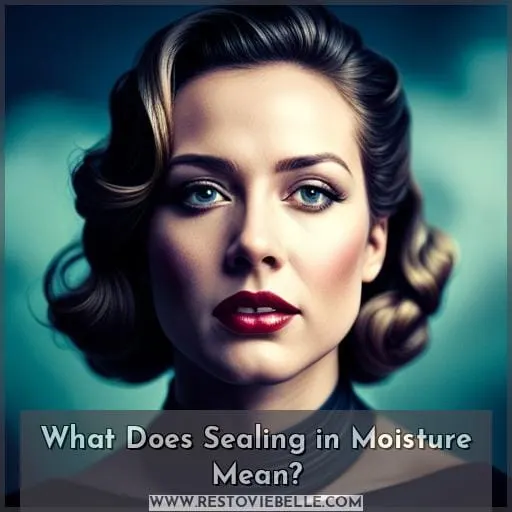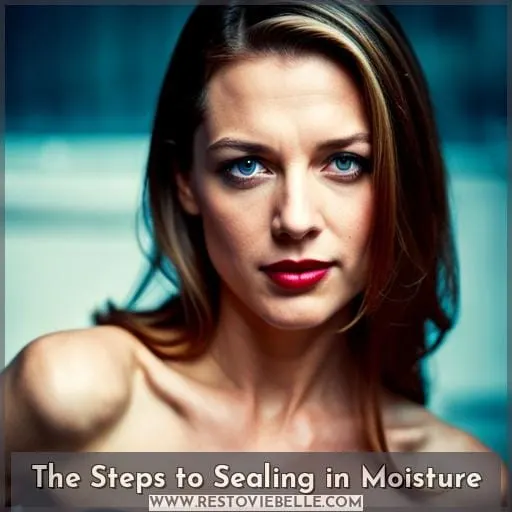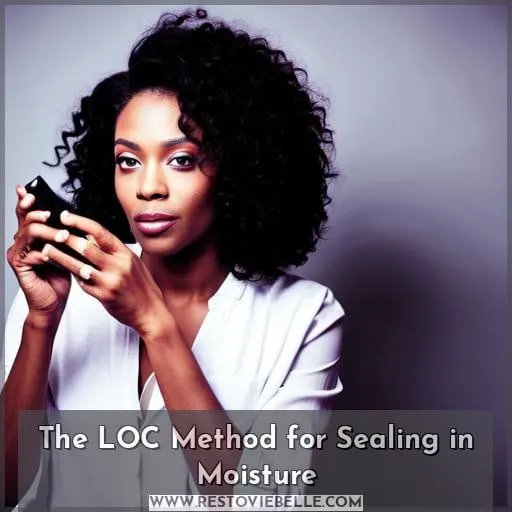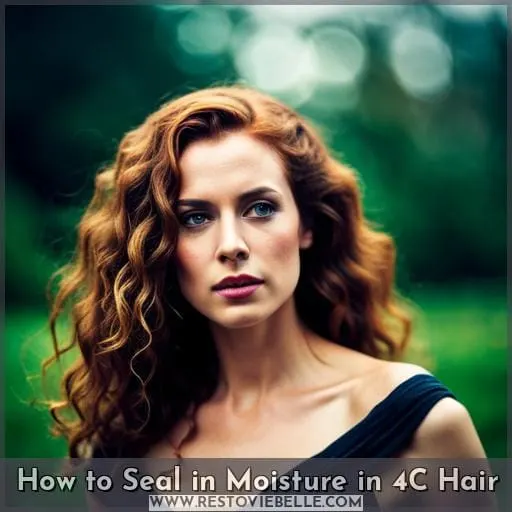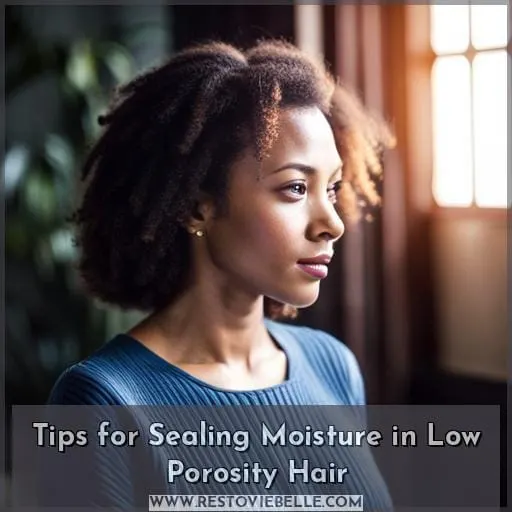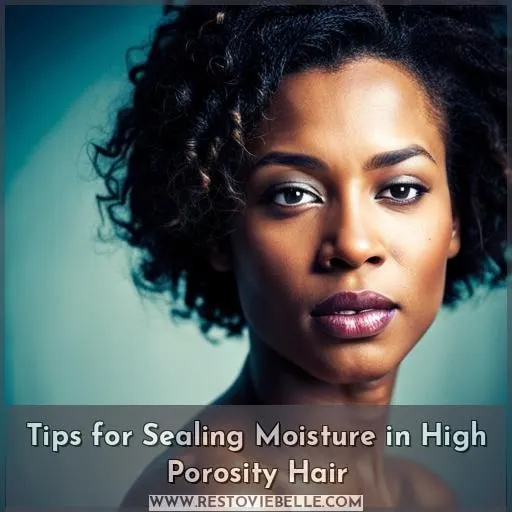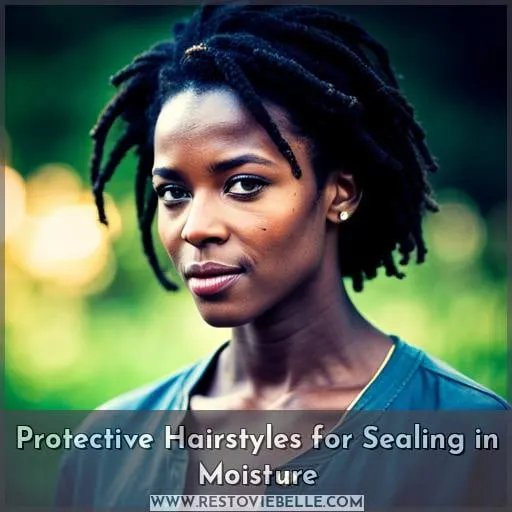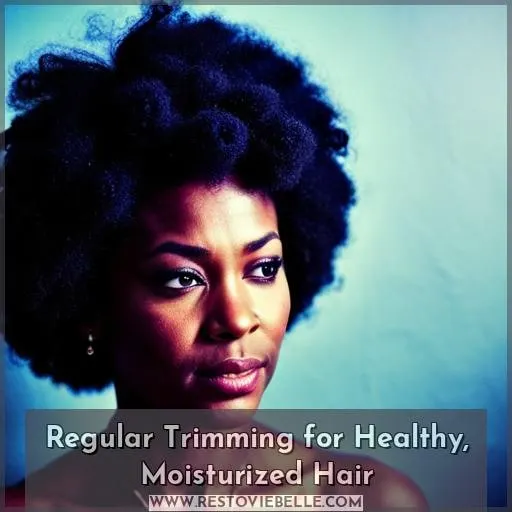This site is supported by our readers. We may earn a commission, at no cost to you, if you purchase through links.
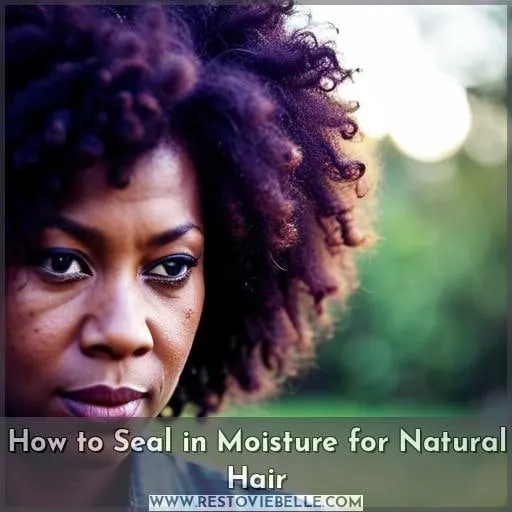 Ah, natural hair. You can be a real handful sometimes! From trying to get the perfect wash-and-go curls to finding out how you should really go about sealing in moisture – it’s enough for any person with natural hair to want to pull their own locks out.
Ah, natural hair. You can be a real handful sometimes! From trying to get the perfect wash-and-go curls to finding out how you should really go about sealing in moisture – it’s enough for any person with natural hair to want to pull their own locks out.
Sealing in moisture is an essential part of having healthy and hydrated hair. Without proper maintenance, your kinks and coils will become dry, brittle, and prone to breakage. But don’t worry! We’ve got the lowdown on exactly how you can seal in that much-needed moisture so all those luscious strands stay strong and beautiful as ever.
Table Of Contents
- Key Takeaways
- What Does Sealing in Moisture Mean?
- The Steps to Sealing in Moisture
- The LOC Method for Sealing in Moisture
- How to Seal in Moisture in 4C Hair
- Tips for Sealing Moisture in Low Porosity Hair
- Tips for Sealing Moisture in High Porosity Hair
- Stay Hydrated for Moisture From Within
- Minimize Heat Exposure to Retain Moisture
- Protective Hairstyles for Sealing in Moisture
- Regular Trimming for Healthy, Moisturized Hair
- Conclusion
Key Takeaways
- Importance of moisture retention for healthy natural hair
- The LOC and LCO methods for sealing in moisture
- Tips for sealing moisture in different hair types (4C, low porosity, high porosity)
- Other factors to consider for moisture retention: internal hydration, heat management, protective hairstyles, and regular trimming
What Does Sealing in Moisture Mean?
Sealing in moisture is essential for healthy natural hair and can be the difference between having dry, brittle strands or a soft, hydrated mane. Sealing involves protecting your hair from losing water molecules due to external factors like wind and heat, while moisturizing adds needed oils back into the strand to prevent breakage.
The Importance of Sealing in Moisture
You must understand your 4C hair type and its characteristics to effectively combat dryness, so make sure you stay hydrated with water and use the right products for sealing in moisture.
Moisture retention is essential to prevent natural hair from drying out. The LOC or LCO methods are popular ways of sealing in hydration using oils or butters; experiment with different techniques until you find what works best for your individual needs.
Additionally, keep up healthy haircare practices such as applying heat protectants before styling, minimizing touching of the hair strands, sleeping on satin bonnets, and trimming regularly.
The Difference Between Sealing and Moisturizing
Surprisingly, sealing and moisturizing your natural hair are two very different processes that can be difficult to keep track of. Sealing techniques involve the use of oils or butters for locking in moisture, while products such as leave-in conditioners are used for moisturizing.
It is important to maintain a balance between these two steps when caring for 4C hair types with low or high porosity levels.
To get the best results from both methods, experiment with various products until you find one that works well on your unique type of hair – then stick to it! Protecting your locks from external elements will help ensure optimal hydration throughout the day, so don’t forget about haircare basics like regular trims too!
The Steps to Sealing in Moisture
To ensure your natural hair stays hydrated and healthy, sealing in moisture is essential. To begin the process of sealing in moisture, start with water to provide a base layer of hydration for your strands.
Step 1: Start With Water
Hydrating your hair is the first step to maintaining its health and vitality. Understanding your hair’s porosity will help determine which techniques are best for sealing in moisture. For example, low porosity hair has tightly closed cuticles, making it difficult for moisture absorption.
So, using a heat cap can open up the cuticles and allow more hydration methods to spread.
Water-based products like leave-in conditioners or creating DIY sprays with water as a base provide excellent moisturization that helps prevent dryness throughout the day.
A popular way to seal in this additional layer of moisture is by following either Rochelle Graham’s LOC method (Liquid, Oil Cream) or LCO Method (Liquid Cream Oil).
No matter what technique you use, make sure you choose suitable products based on your specific needs, such as oils like fractioned coconut oil and argan oil that both seal AND moisturize!
The LOC Method for Sealing in Moisture
Are you looking for an effective way to keep your natural hair moisturized? The LOC method could be the answer! This acronym stands for Liquid, Oil, and Cream – using water as a base, selecting the right oils for sealing in moisture, and finding the ideal cream or butter.
Liquid: Using Water as the Base
Starting with water as your base is the best way to keep your hair hydrated and vibrant. Use a water spray bottle for even coverage, dividing sections of hair for thorough moisturizing. Seal in this moisture by incorporating oils or butters like Jamaican black castor oil, mango butter, or shea butter into your routine.
High porosity locks need more attention; use a heat cap to open cuticles so they can better absorb moisture from products applied afterward.
Oil: Choosing the Right Oils for Sealing
Choosing the right oils for sealing is key to keeping your hair hydrated and healthy. Try experimenting with different types like Jamaican black castor oil, jojoba oil, grapeseed oil, mango butter, and cocoa butter! Oils have many benefits that help seal in moisture.
Natural haircare products such as shea butter or a satin bonnet can provide an extra layer of protection. When applying oils to your hair, make sure you use enough product so it properly seals in all the moisture.
Don’t forget about deep conditioning treatments, which are great for replenishing lost nutrients in order to keep strands strong and moisturized.
Cream: Finding the Ideal Cream or Butter
Unlock the power of your natural hair’s potential with an ideal cream or butter! Choose products specifically formulated for your curls and coils; DIY recipes, Shea Moisture, natural oils are great options.
Incorporate them into a healthy hair care routine to keep it hydrated and full of life.
How to Seal in Moisture in 4C Hair
If you have 4C hair, it is important to understand its unique characteristics and needs in order to keep your hair moisturized. With the right techniques and products, you can combat shrinkage and dryness while also sealing in moisture for healthy, natural hair.
Understanding the Unique Needs of 4C Hair
Understanding your 4C hair type and its unique needs is key to keeping it moisturized. With tightly coiled strands, 4C hair tends to be drier than other types, so sealing in moisture is essential for healthy locks.
Start by hydrating with plenty of water every day. Then, use a spray bottle or applicator brush to evenly distribute water over the scalp and throughout sections of the hair.
Appropriate products, such as oils like Jamaican black castor oil, can help seal in hydration. Butters like mango butter provide added nourishment that helps protect each strand from dryness and breakage.
For extra protection against frizziness and dehydration overnight, consider sleeping with a satin cap on your head.
Try experimenting with different techniques until you find what works best for you.
Tips for Sealing Moisture in Low Porosity Hair
If you have low porosity hair, understanding its unique characteristics and how to effectively seal in moisture is essential. There are a variety of techniques that can help improve your hair’s ability to absorb and retain moisture, such as using the right products for your hair type or experimenting with heat-free styling alternatives.
Understanding Low Porosity Hair
Recognizing your low porosity hair is like trying to open a locked door with the key already in hand. Low porosity techniques, such as scalp massages and protein treatments, can be effective for increasing moisture absorption.
High porosity strategies help retain it by sealing in moisture with oils and butters. To maximize hydration, use heat caps or deep conditioning treatments regularly for better penetration of products into cuticles that are tightly closed.
Techniques for Better Moisture Absorption
Discover the best techniques for better absorption of moisture into your low porosity hair and unlock a newfound level of hydration, shine, and health! Consider investing in a heat cap to open cuticles for improved water uptake.
Regularly massage your scalp with natural oils to evenly distribute them throughout the hair shaft. Protein treatments can fill gaps in strands while leave-in conditioners help retain vital moisture.
Protective hairstyles are great barriers against harsh elements which may cause dryness too.
Tips for Sealing Moisture in High Porosity Hair
If you have high porosity hair, it is important to understand its unique characteristics and how to prevent moisture loss.
Understanding High Porosity Hair
High porosity hair is characterized by open cuticles, leading to more moisture loss. To retain hydration and achieve healthy hair, use sealing techniques such as the LOC/LCO method with oils or butters.
Additionally, apply a protein treatment to close any gaps in the hair shafts and balance it with moisturizing products for optimal results. Pay attention to breakage prevention when styling and opt for protective hairstyles on occasion; regular trimming also helps prevent dryness from split ends.
Techniques for Preventing Moisture Loss
To keep your high porosity hair healthy and hydrated, try implementing sealing techniques like the LOC or LCO method. Product selection is key: choose a conditioner to address frizzy hair, breakage, and length retention needs.
Scalp massages aid in distributing natural oils for moisture, while the use of a heat cap helps open cuticles for better absorption. Protein treatments fill gaps in the shaft but should be balanced with moisture for optimal results.
Stay Hydrated for Moisture From Within
Maintaining healthy, moisturized natural hair requires more than just external treatments. Staying hydrated from within is essential to keep your curls looking their best and preventing dryness. Drinking at least two liters of water daily should be the foundation of your routine, but there are other hydrating habits you can incorporate into your lifestyle as well for optimal results.
The Importance of Drinking Water
It’s essential to keep your 4C hair moisturized, and drinking plenty of water each day is key to achieving this! Hydration benefits include improved scalp health, stronger strands that are less prone to breakage, and a balanced pH level throughout the entire hair follicle.
Increasing your daily water intake helps seal in moisture for healthy-looking type 4 curls. Developing healthy hydration habits keeps you on track with proper hydration levels needed for optimal hair growth and retention.
It also aids in nourishing the scalp, which is important when it comes to sealing in moisture from within natural hair types like 4C curly strands.
Drinking adequate amounts of water per day should be part of any good haircare routine as it plays an integral role in maintaining overall well-being, as well as promoting strong, radiant tresses that will last through any season!
Other Hydrating Habits to Consider
In addition to drinking enough water, there are other hydrating habits you can adopt that will help keep your hair moisturized and healthy. For instance, 90% of Americans wear hats during the winter months. To seal in moisture for natural hair, you can follow these steps: 1) Hydrate with a nighttime routine; 2) Use products based on porosity; 3) Incorporate heat protection when styling; 4) Apply hydrating leave-in conditioners.
Regular trims and protective hairstyles also work well to protect from environmental elements while adding an extra layer of moisture retention.
Minimize Heat Exposure to Retain Moisture
Heat exposure can wreak havoc on natural hair, leading to dryness and breakage. Luckily, there are heat-free styling alternatives, such as protective hairstyles, that will shield your locks from the elements while retaining moisture.
The Damaging Effects of Heat on Natural Hair
You may be tempted to reach for the flat iron, but heat styling can have a detrimental effect on your natural hair’s moisture levels.
Protective styles are essential for retaining and preserving moisture in 4C strands. Consider implementing heat-free hairstyles like buns or braids to reduce your reliance on hot tools and promote healthy growth from within.
Natural haircare should also include regular deep conditioning treatments. Additionally, using water sprays, oils, creams, and butter to seal in hydration throughout the day without sacrificing style or beauty is crucial!
Investing time into researching alternative methods such as these will help you find better ways to maintain healthy locks while avoiding unnecessary exposure to damaging high temperatures that cause breakage and lead to dryness over time!
Heat-Free Styling Alternatives
Explore heat-free styling options to keep your mane hydrated and healthy! Braiding techniques like box braids and cornrows are great protective styles that help retain moisture. Overnight options such as twists, bantu knots, or pineappleing also provide a way to protect hair from the elements while sleeping.
Twisting styles can be achieved with two-strand twists or Marley twist-outs for definition without heat damage. Hair accessories such as headbands, scarves, and hats prove useful in keeping flyaways tamed without using any hot tools.
Protective Hairstyles for Sealing in Moisture
Protective hairstyles are an effective way to keep natural hair healthy and moisturized. Not only do they reduce the damage caused by excessive heat exposure, but they also come in a variety of styles to suit different needs.
From braids to twists, protective hairstyles can help seal in moisture while providing long-term benefits for your hair health.
The Benefits of Protective Hairstyles
Protective hairstyles are like a shield for your hair, helping to lock in hydration and keep it safe from the elements. Braiding, twisting, and cornrowing can all be beneficial protective styles that require minimal upkeep.
Wearing them will reduce friction between strands of hair, which helps maintain moisture levels longer than other styling methods. Protective hairdos also provide an opportunity to experiment with different looks while taking breaks from heat tools or color treatments for healthier locks over time.
You can try out twist outs, braid outs, or even updos if you want to switch up your style without compromising moisture retention! Finally, caring properly for any braided protective style is key; use a light oil-based product when moisturizing, as heavier products may cause build-up and lead to dryness.
Different Types of Protective Hairstyles
Try various protective hairstyles to lock in hydration and maintain hair health. Braid styles like box braids, cornrows, and Senegalese twists help you keep your natural hair free from the elements while still looking stylish.
Twists are also great for a low-maintenance look that’s easy to manage and provides an opportunity for added accessorizing.
Wig options can be used to give yourself versatility with different looks without compromising moisture retention or styling time. If you want something more creative than traditional updos, consider trying French braids or half-up/half-down dos with intricate parts or buns that flatter your face shape! There’s plenty of room within these classic styles for variations too.
Regular Trimming for Healthy, Moisturized Hair
It is essential to maintain regular trims for healthy, moisturized natural hair. Regularly trimming your ends prevents breakage and dryness, preserving the length of your locks while keeping them hydrated and healthier for longer.
The Importance of Regular Trims
Regular trims are key to keeping your hair looking and feeling its best, as they help ensure healthy ends and prevent split ends. Regularly trimming the tips of natural hair helps maintain a desired length while protecting against breakage.
It also eliminates single strand knots that can contribute to tangles, frizziness, and further damage down the line.
Split ends should be trimmed off immediately because if left untreated, they will travel up the shaft of your hair, leading to more breakage which impacts overall health negatively.
How Trimming Prevents Breakage and Dryness
Regularly trimming your hair helps prevent breakage and dryness, locking in vital nutrients for healthy, moisturized locks.
- Moisture retention to reduce the appearance of split ends and keep hair looking hydrated.
- Breakage prevention due to improved elasticity from the removal of weakened strands.
- Improvement in hair health by removing buildup that can cause damage or irritation.
- Length maintenance over time with more even growth.
Trimming is an effective way to ensure your natural tresses stay strong, nourished, and vibrant! By taking care to regularly trim away damaged pieces, you will achieve greater retention length while keeping your curls healthy and happy.
Conclusion
So, now that you have all the information you need to seal in moisture for your natural hair, you’re ready to start keeping it healthy and nourished.
Start with water by using a spray bottle for even coverage. Consider using the LOC or LCO method for sealing in moisture, and make sure to choose the right oils and creams.
For 4C hair, scalp massages and heat caps can help open up cuticles for better absorption.
For low porosity hair, use a protein treatment to fill gaps in the hair shaft.
For high porosity hair, use a combination of protein treatment and moisture to get the best results.
Finally, stay hydrated, minimize heat exposure, use protective hairstyles, and trim your hair regularly to retain moisture.
With these tips, you’ll be on your way to having healthy, moisturized natural hair!
